|
The Street
Barham
01227 831396
http://dukeofcumberland.co.uk/
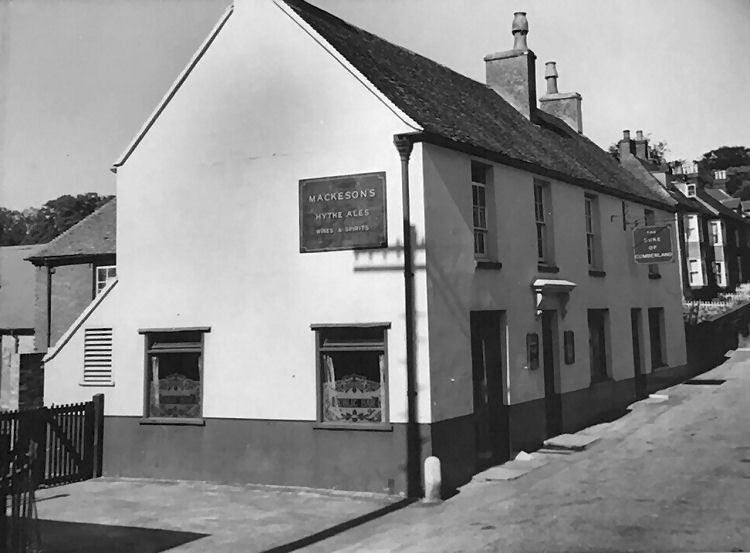
Above photo circa 1937, kindly sent by Rory Kehoe. |
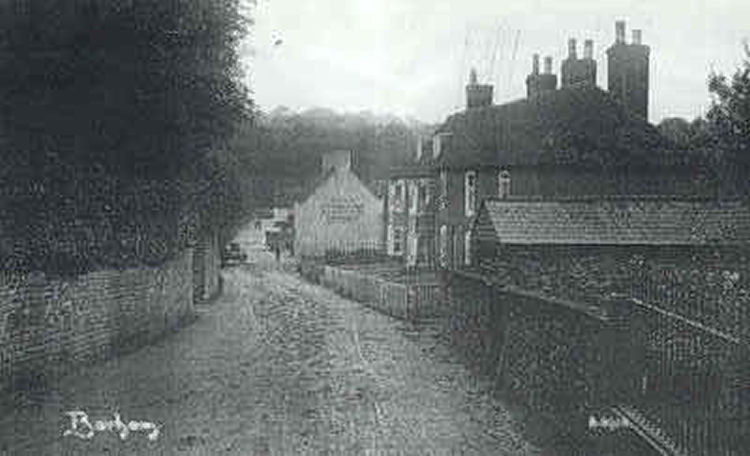 Above photo by kind permission of
http://www.barham-kent.org.uk |
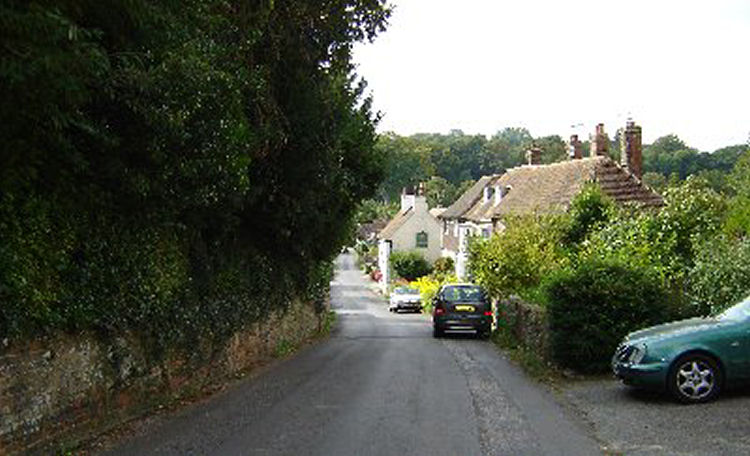
Same view below 2007, by Paul Skelton. |
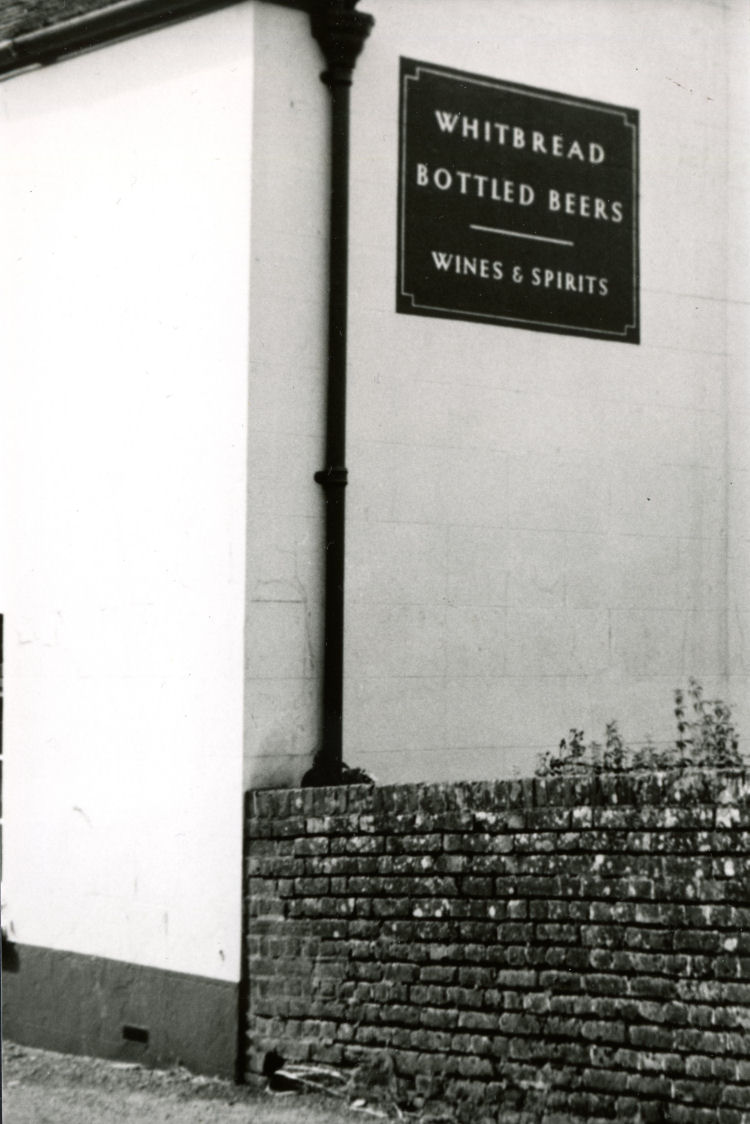
Above photo 25 August 1960, kindly sent by Clive Bowley. |
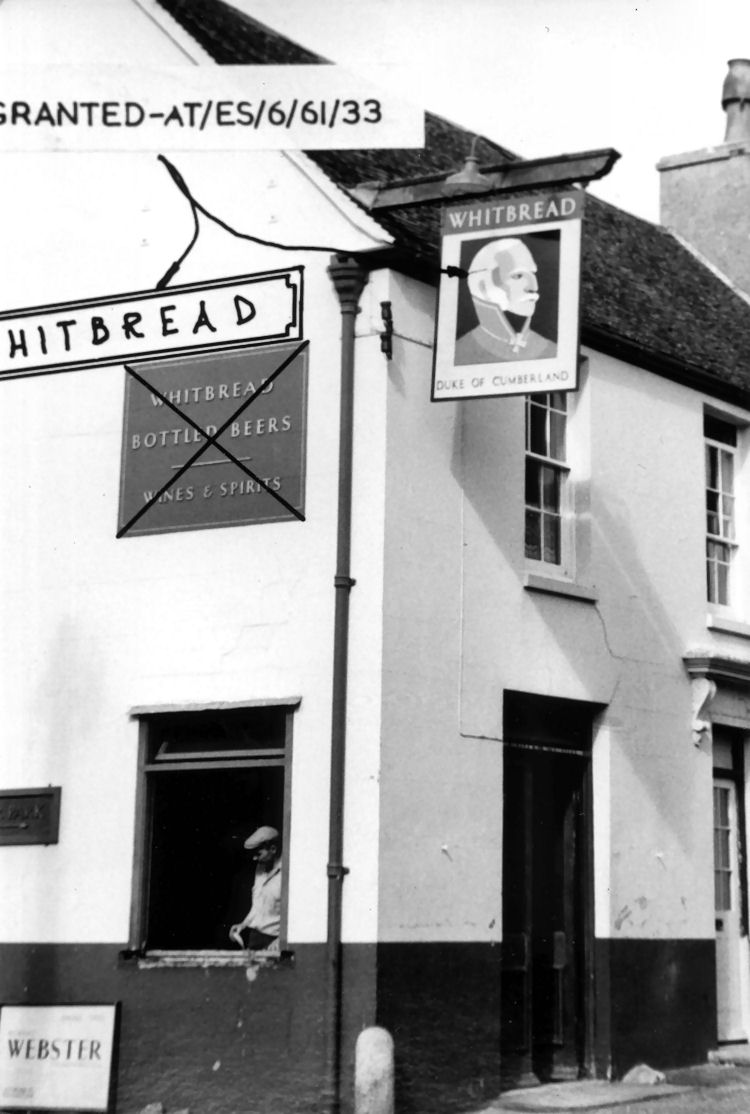
Above photo 25 August 1960, kindly sent by Clive Bowley. |
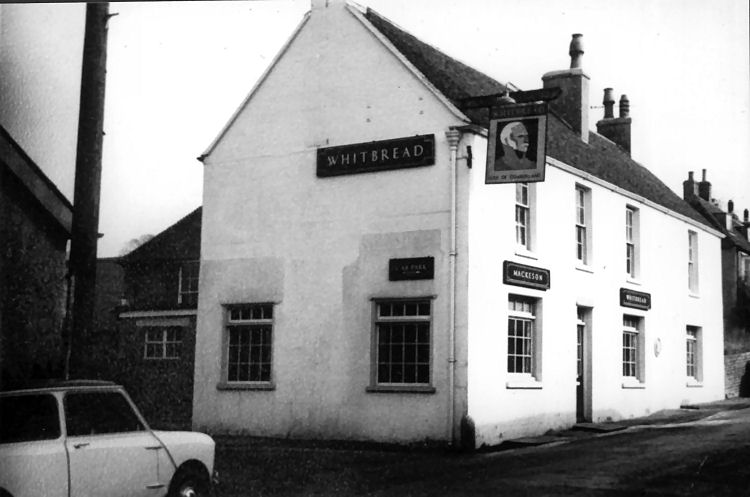
Above photo 25 August 1960, kindly sent by Clive Bowley. |
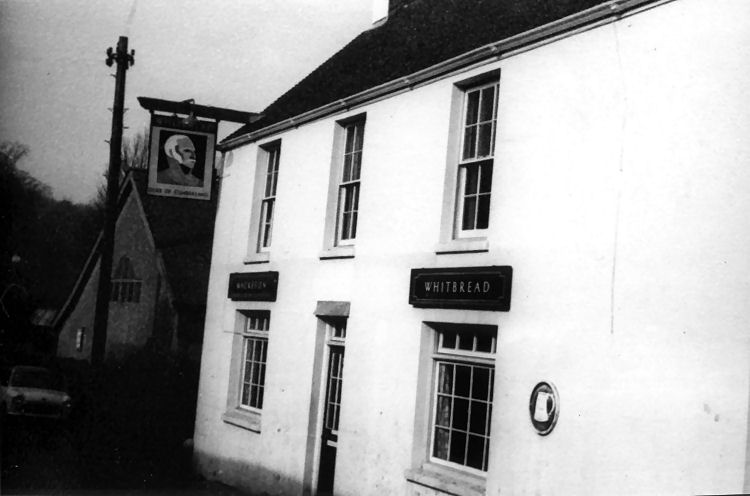
Above photo 5 March 1963, kindly sent by Clive Bowley. |
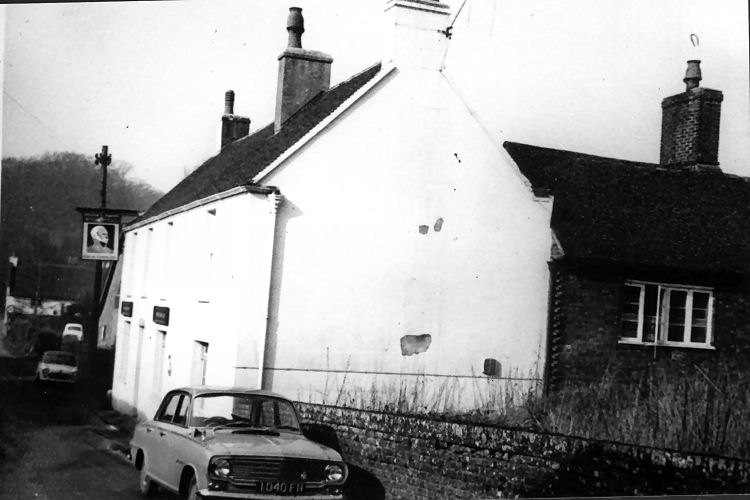
Above photo 5 March 1963, kindly sent by Clive Bowley. |
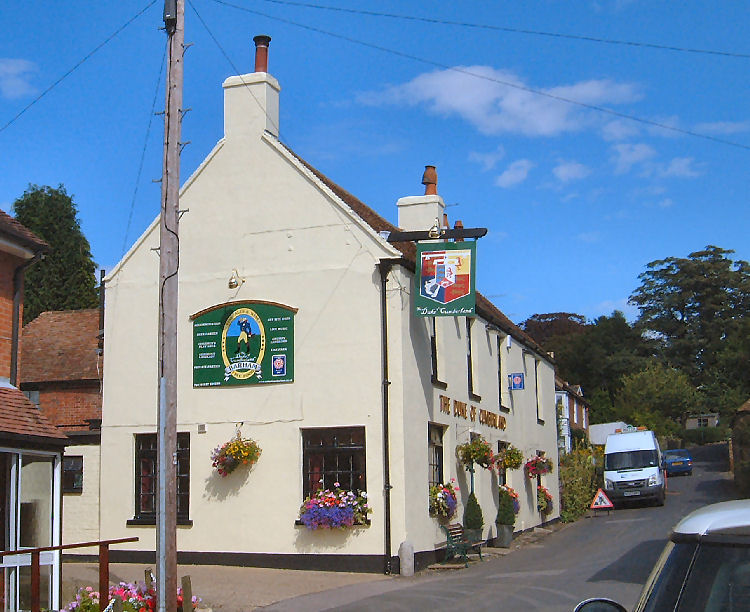 Above
photo by Paul Skelton, 22 Aug 2008. |
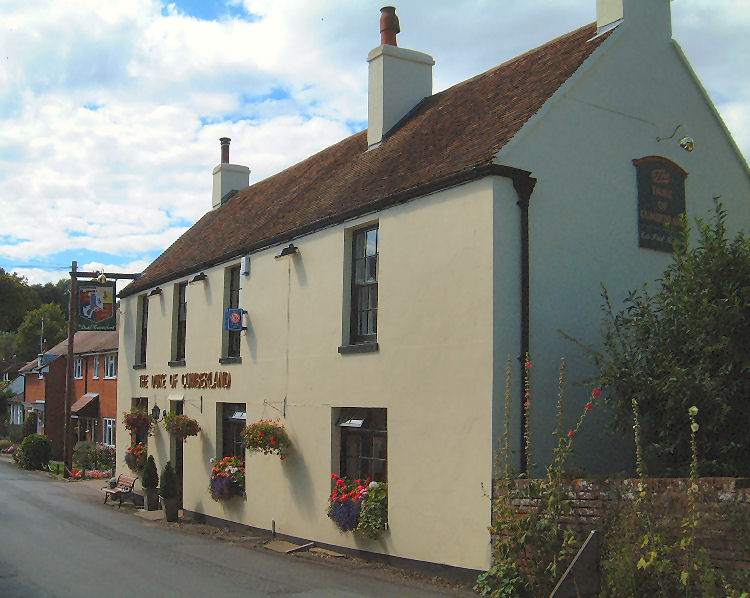 Above
photo by Paul Skelton, 22 Aug 2008. |
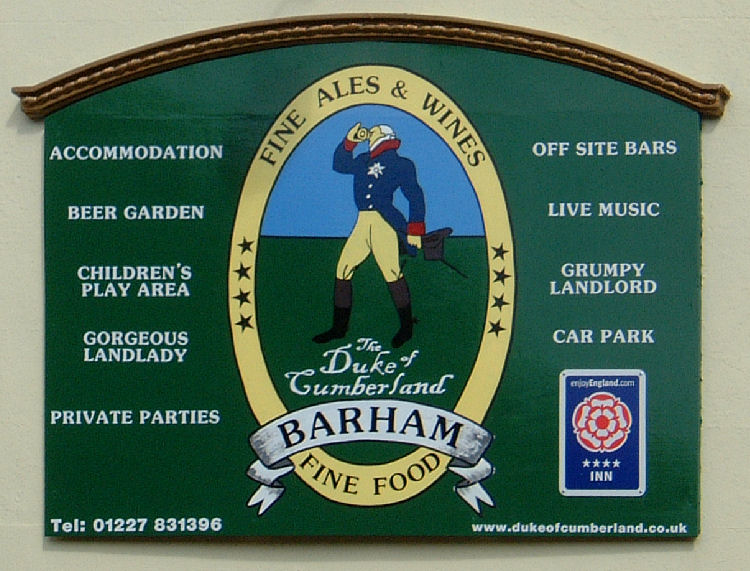 Above
photo by Paul Skelton, 22 Aug 2008. |
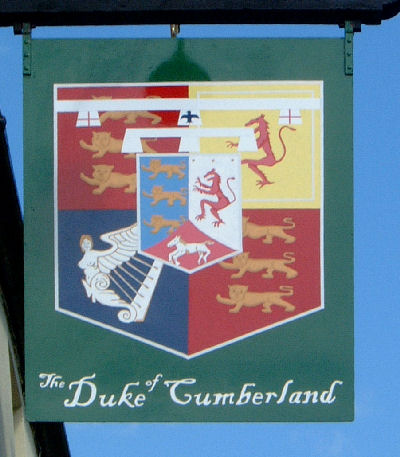 Above
photo by Paul Skelton, 22 Aug 2008. |
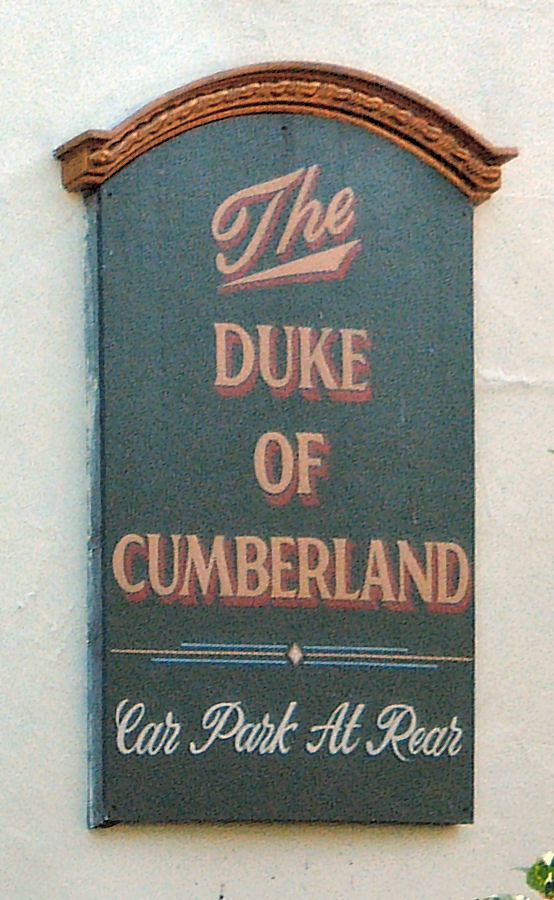
Above photo by Paul Skelton, 22 Aug 2008. |
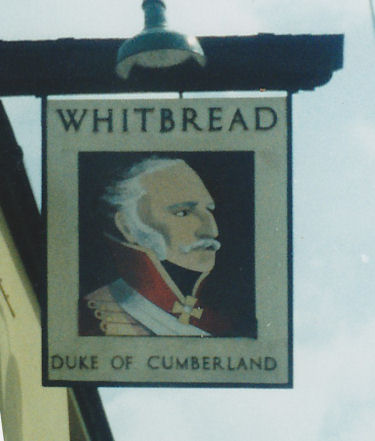 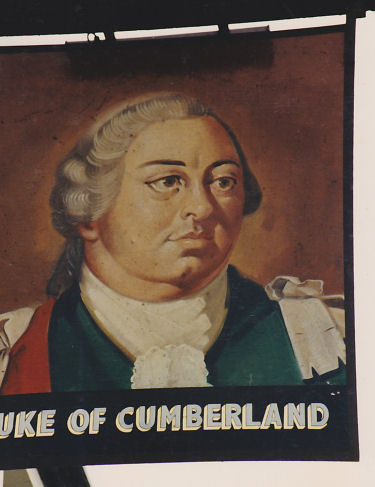
Sign left, May 1991, sign right, July 1986
Above with thanks from Brian Curtis
www.innsignsociety.com
|
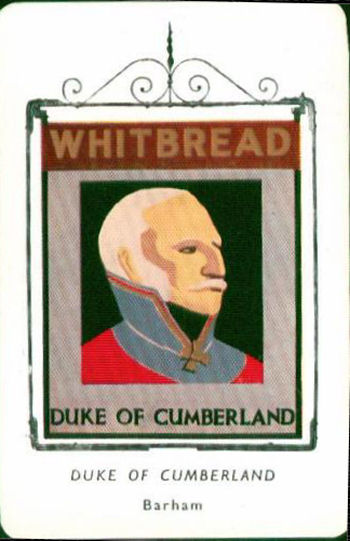 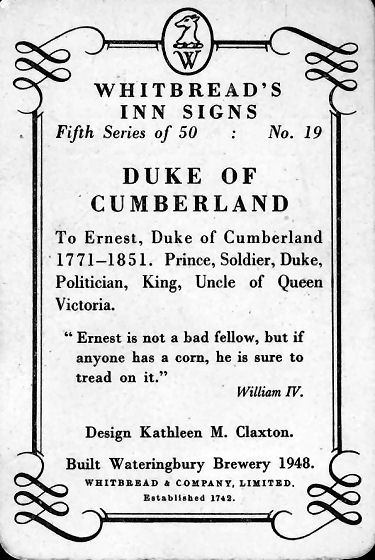
Above card issued April 1955. Sign series 5 number 19.
|
|
From the Kentish Gazette, Wednesday, 3 August to Saturday, 6 August, 1768. Price 2d
TO BE SOLD BY AUCTION
Or private Contract, at the Sign of the “Duke of Cumberland,” in Barham,
on Thursday the 11th of August, Inst.
An Entire New House, consisting of Nine Rooms, besides Closets, a good
Well, and Garden Spot belonging to it, pleasantly situates in the Parish
of Barham, belonging to Thomas Webb, of the said Parish.
Barham, Aug. 2, 1768.
|
|
From the Kent Herald, 19 January 1826.
Kent. Freehold and Leasehold Public Houses and other Estates.
At Word, Fingersham, Northbourne, Sutton (next Dover,) Eastry, Tilmanstone,
Eythorne, Frogham, Womenswould, Addison, Barham, Woodnesborough, Goodnestone
(next Wingham,) Ash (next Sandwich,) Shoulden, Walmer, Ramsgate, Margate, Sarr.
St. Peter's, (Thanet) and Sandwich.
For sale by auction, by Pott and Denne.
At the "Bell Inn," in Sandwich, on Monday, the 13th day of February, 1826, at 11
o'clock in the forenoon precisely, (subject to such conditions and restrictions
as will be then and there produced,) the following Freehold and Leasehold Public
Houses and Estate's, in 27 lots, viz:-
Lot 1:- The "Crispin," public house, at Word.
Lot 2:- The "Jolly Gardener," ditto, at Finglesham, in the parish of Northbourne.
Lot 3:- The "Hound and Hare," ditto, at Northbourne.
Lot 4:- The "Star and Boot," ditto, at Sutton (next Dover.)
Lot 5:- The "Bull," ditto, at Eastry, with cottage adjoining.
Lot 6:- The "Three Colts," ditto, at Tilmanstone.
Lot 7:- The "White Horse," ditto, at Eythorne.
Lot 8:- The "Red Lion," ditto, at Frogham.
Lot 9:- The "Rose and Crown," ditto, at Woolwich Green, in the parish of Womanswould.
Lot 10:- The "Bull Head," ditto, at Adisham.
Lot 11:- The "Duke of Cumberland," ditto, at Barham.
Lot 12:- The "Charity," ditto, at Woodnesborough.
Lot 13:- The "Three Crowns," ditto, Goodnestone (next Wingham.)
Lot 14:- The "Admiral Harvey," ditto, at Ramsgate.
Lot 15:- The "Ship," ditto, at Ramsgate, with two small cottages at the back.
Lot 16:- The "Red Lion," ditto, at St. Peter's, (Thanet) with cottage adjoining.
Lot 17:- The "Crown and Thistle," ditto, at St. Peters, Thanet.
Lot 18:- The "Crown," ditto, at Sarr.
Lot 19:- The "King's Head," ditto, in Walmer Road.
Lot 20:- The "Duke of York," ditto, in Walmer Road.
Lot 21:- The "Chequers," ditto, in the Sandhill's, in the parish of Shoulden.
Lot 22:- The "Ship Inn," at Ash next Sandwich with extensive stabling, yard,
Gardens, &c.
Lot 23:- A Dwelling House, near or adjoining the last lot, in the occupation of
Mrs. Maria Green.
Lot 24:- Three Cottages, adjoining the last lot, with the gardens used theirwith,
now in the several occupations of Vincent Noble Kennard, John Harrison, and
Steven Solly.
Lot 25:- All that building and Hop Oast, next or adjoining the last lot now in
the occupation of Mr. Thomas Minter Tomlin
Lot 26:- A Freehold Dwelling House, and Premises, in Church Square, Margate, in
the occupation of William Dale.
Lot 27:- The "New Inn," in Sandwich, with Assembly Room, Theatre, Stables,
Yards, &c.
N.B. Lots 19, 20, and 21, are leasehold, and all the others freehold.
The premises may be viewed on application to the respective tenants, and printed
particulars had (seven days prior to the day of sale) of the auctioneers, and at
the "Bell Inn," Sandwich; "Kings Head Hotel," Canterbury;
"Antwerp Inn" Dover;
"Black Horse Inn," Deal; "Spread Eagle Inn," Ramsgate; "York Hotel," Margate; of
Mr. Benjamin Hall, Solicitor, No. 2, Serjeant's Inn, Fleet Street, London; and
at the offices of Mr. Noakes, Solicitors, Sandwich.
|
|
Sussex Advertiser 20 February 1826.
At the sale of the public houses and other estates, situate in the eastern
parts of the County of Kent, which took place at the "Bell Inn," Sandwich,
on Monday last, Messrs. Pott and Denne knocked down the following lots, at
the sums affixed to them, viz.:—
The "Bull," at Eastry, £1,190.
"Three Colts," Tilmanstone, £500.
"White Horse," Eythorne, £575.
"Red Lion," Frogham, £455.
"Rose and Crown," Womenswould, £166.
"Duke of Cumberland," Barham, £910.
"Charity," Woodnesborough, £710.
"Three Crowns," Goodnestone, £620.
"Admiral Harvey," Ramsgate, £1,150.
"Ship," Ramsgate, £1,250.
"Red Lion," St. Peters, £1,100.
"Crown and Thistle," St. Peters, £705.
"Crown, or Halfway-house," Sarr, £940.
"King's Head," Walmer Road, £425.
The "Duke of York," Walmer Road, £310.
The sale-room was most numerously attended.
We understand that the "Ship," at Ash, and "Crispin," at Worth, have since
been sold by private contract, the former for £750, and the latter for five
hundred guineas.
|
|
From the Kentish Chronicle, 25 April, 1863.
DETERMINED SUICIDE OF A FEMALE AT BARHAM.
On Friday the deputy coroner, W. P. Callaway, Esq., held an inquest at
the “Duke of Cumberland Inn,” in this parish, on the body of Francis
Allen, whose death resulted from hanging. George Allen (the husband of
the deceased) deposed that his wife was 57 years of age, and he had been
married to her 18 years, Four years since she became very strange, and
was then attended by Mr. Long. About last October deceased got worse but
he had never heard her threaten to destroy herself. On the previous
morning deceased breakfasted with witness, after which he went to work
in the garden about quarter before nine o'clock. About ten o'clock, on
going indoors, he saw the deceased lying dead on the floor, with the
cord of a shower bath round her neck. From the position the body was in
it appeared that she had fallen, through the rope having broken. The
deceased was alone in the house when witness left her. Jane Morgan, a
neighbour, said she was called in by the husband of the deceased, and
found her lying on the floor, as described by the previous witness.
Verdict, “That the deceased hanged herself whilst in an unsound state of
mind.”
|
|
From the Canterbury Weekly Journal, 25 April 1863.
BARHAM.
Determine Suicide of a Female.
On Friday last, the deputy coroner, W. P. Callaway, Esq., held an inquest at the
"Duke of Cumberland Inn," in the parish, on the body of Francis Allen, whose
death resulted from hanging. George Allen (the husband of the deceased) deposed
that his wife was 57 years of age, and he had been married to her 18 years. Four
years since she became very strange, and was then attended by Mr. Long. About
last October deceased got worse, but he had never heard her threaten to destroy
herself. On the previous morning deceased breakfasted with witness, after which
he went to work in the garden about a quarter before 9 o'clock. About 10
o'clock, on going indoors, he saw the deceased lying dead on the floor, with a
cord of a shower bath round her neck. From the position the body was he in it
appeared that she had fallen, though the rope having broken. The decease was
alone in the house when witness left her. Jane Morgan, a neighbour, said she was
called in by the husband of the deceased, and found her lying on the floor, as
described by the previous witness.
Verdict:- "That the deceased hanged herself whilst in and unsane state of mind."
|
|
From the Kentish Chronicle, 30 January, 1864.
TROTTING MATCH for £20.
On Monday afternoon a trotting match, for £10 a side, took place on the
Canterbury and Dover Turnpike road, between a cob belonging to Mr.
Burren, of the “Providence Inn,” Northgate, Canterbury, and it chestnut
mare belonging to Mr. Charles Hornsby, of the “Duke of Cumberland Inn,” Barham. The distance was two miles—from Lydden Hill to the “Halfway
House.” Belting was even at starting, and the match, which was a very
close and exciting one, terminated in favour of Mr. Burren’s cob by two yards, The
two miles was accomplished in two seconds under seven minutes.
|
|
From the Southeastern Gazette, 12 June 1866.
Charles Hornsby, landlord of the “Duke of Cumberland Inn,” Barham, was
summoned for permitting gambling in his house. The case having been
stated by B.C. Stickley, the defendant said he did not deny that cards
were played, but declared the game was not for money or money’s worth.
Having called a witness who substantiated this statement, the Bench
dismissed the information.
|
|
From the Whitstable Times and Herne Bay Herald, Saturday 13 September 1879.
Charles Edward Stevens, son of the landlady of the "Duke of Cumberland"
public house at Barham, stated that on Sunday evening, the 17th August,
the defendants came to his mother's house, and had some beer. They then
created a disturbance in the tap-room, and not complying with his
request when he asked them to leave, he sent for the police. They were
very drunk.
Both defendants denied being either drunk or disorderly, and said they
left the house when the constable told them to do so. they called Robert
Hawkin, who stated that he met the younger defendant going down the
street at Barham at about ten minutes past nine on the evening in
question. he was quite sober.
Stevens was then recalled, and denied that they were not creating a
disturbance.
Both defendants were fined 5s. and 10s. costs for refusing to quit the
licensed premises, and 5s., and 11s. costs for the other offence, or the
alternative of seven day's imprisonment each on both charges.
|
|
From the Whitstable Times, 1 March, 1902.
BARHAM. SOLDIERS IN TROUBLE.
John Cunningham, Fred Lahiff, and John Ryan, privates in the Leinster
Regiment, and Edward Brazil, private in the Dublin Fusiliers, were
charged with stealing a bottle of brandy, the property of George Henry
Crosby, landlord of the “Duke of Cumberland,” Barham.
Prosecutor deposed to the prisoners coming to his house twice on the
previous Sunday. After they had gone the second time he missed a bottle
of brandy. He believed the bottle produced in Court was his property.
Sergeant Heard stated that at midnight on the 2nd inst. he was with P.C.
Hubbard when they found the four prisoners sleeping near a straw slack
on Kingston Court Farm the bottle produced was lying on the straw just
above the prisoners heads. The bottle contained about three parts of a
quartern of brandy. Witness woke the prisoners up. They all had a drink
out of the bottle (laughter), and he then arrested them on a charge of
being deserters. At 11a.m. on the 3rd inst. witness charged the four
prisoners with the present offence. Lahiff replied “I took the bottle,
but we were all together at the time.” Cunningham said “I was the first
to leave the house. I was not with them when they took the bottle.”
A sergeant of the Leinster Regiment from Dover, where the prisoners are
stationed, gave Brazil und Ryan good characters. With regard to the
other two men they had been convicted for military offences.
The Chairman said Ryan and Brazil had good characters and it was a pity
they should have been led astray. They would he bound over to come up
for judgment if called upon. There were only military offences against
Cunningham and Lahiff, and therefore, they would also he bound over.
|
|
From the Dover Express and east Kent News, Friday 2
September, 1938.
The licensee of the "Duke of Cumberland," Barham, was granted an
occasional licence from 8-11 p.m. on 8th September, for a concert and
dance at the Village Hall, organised by the Lavender Hill Division,
Metropolitan Police Football Club, and the Barham Football Club.
|
|
This extract is from the book "Inns of Kent"; Whitbread & Co. Ltd.; 1948:-
From The Three Horseshoes (Lower Hardres) it is not far to Barham,
another of those perfect villages just off the Dover road, with never a
house less than a couple of centuries old, and The Duke of Cumberland is
in keeping.
|
|
Saturday 21st April 2007. Ghost Search.
The site of this wonderful old building has had a staging inn upon it
going as far back as 1640 with stables at the rear. The present building
was built in 1749 & named after the then "Duke of Cumberland (1771 -
1851)," who trained his troops on Barham Downs. He also led the British
Army against the Scots at the "Battle of Culloden" on the 16th April
1746.
This is a large pub and one that is allowing us to explore and
investigate all rooms including those in the living quarters. The new
landlord and landlady (approx 18 mths) have experienced some bizarre
phenomena that they cannot explain. They told me of a village power cut
they had and how some of the residents decided to go their local during
the blackout. Duncan and Karen (landlord/lady) lit some candles and
carried on as best they could with pub life. Karen said she had laid out
the dinning room tables and was coming and going from dinning room and
kitchen. Karen noticed that the cutlery had been moved, knives and forks
had been crossed over, basically ‘someone' was un-arranging the work she
had done. According to Duncan no-one had been in that area to touch the
tables. Another time when the family had retired to bed they became
aware of light seeping through the loft hatch, some-one had turned the
light on, but they knew no-one had been up there. The light switch can
only be turned on from inside the loft itself and to this day they
cannot offer an explanation. There is one room that Karen does not
partially like due to the atmosphere, in this room we came across a male
energy that had his life cut short. We know this was by strangulation,
but are unclear as yet if this were due to an accident or not. Not only
do we have two dogs that come back to this location (a Jack Russell and
Boarder Collie), we also found on site an additional six resident
energies, four male and two female. A male Spirit who introduced his
name as Conner asked us to ‘get out', this was in the oldest room in the
pub and it was not open to ladies (his time). He was a kind man though
and relented on us being in the room when he realised we were interested
in what he had to say. A young lad who passed over from smoke inhalation
when the stables had a small fire also stepped forward, although he was
shy he seemed pleased that perhaps an offer of help may come forward yet
was willing to wait for our return. Vanessa was a great joy to talk to,
she was at one time a scullery maid who had worked within this building
for many years. I think Vanessa will be a great provider of information
as she loves to chat. Audible noises, I feel, will be quite evident on
the night and the pockets of high energy (due to underground water) will
provide Spirit with the extra power to step forward. We also found the
Spirit to be not only chatty but also willing to try to give evidence of
their survival.
The Investigation Report
This investigation saw me hobbling with a broken toe, but I'm so pleased
to say the pain of standing around was rewarded with a fantastic night
for my team.
Working in the oldest part of the pub, which is now a dinning area, we
came across a real character. Communication was made via glass work and
this Spirit had me scratching my head and questioning my sanity for a
while! As soon as the glass responded to is ‘any one there' I instantly
felt a male energy join us, he was an elderly man but kept his identity
to himself. Upon questioning him, as a way of giving visual evidence to
my guests of what I could 'feel', I asked the Spirit present if he was
male. The glass moved swiftly across the table and rested in front of
Emma (Emma was preordained as a NO and I YES). I told the guests that I
only felt a male energy in the room and no female. I then asked "are you
female", the answer given was yes. I told my team that I didn't
understand as no female was present, I again asked "are you male", again
the answer was No.
A number of other questions were asked like are you happy: Yes. Did you
reside here: Yes. I asked if the Spirit in question was standing next to
me on my left (I could feel the energy), the answer was yes. I again
said ‘but I feel you as male and not female'. I then watched the energy
move in a clockwise direction around the table where we were working,
the energy stopped just in front of me this time on my left. It was then
that I saw a pipe. I said "Well I've never seen a woman smoke a pipe
like that, are you trying to make me look silly?" The glass indicated
YES. It was only then that he admitted to be male…if nothing else it
gave evidence that even when in Spirit you never lose your sense of fun.
The lounge located on the upper floor proved to be a real gem. A lady
came through and gave her name as Isabella. She wore a bonnet which made
giving a height a little difficult; Isabella smiled at me and kindly
removed her head-wear in order for me to note that she stood
approximately 5'5" – 5'6". Her hair was parted in the middle and was
very neatly brushed and tied up in a bun which sat at the nape of her
neck, her hair colour was a very light gingery blonde. She was wearing a
dress with a high neck line and was made from heavy looking material
which fell to just above her shoes, the sleeves on her dress were quite
tight fitting and finished on the palm of her hands. The shoes
themselves were dark in colour and were without a heel. Isabella said
that she was 33 years of age when she passed over and got upset when she
thought of her passing, I told Isabella to not worry with talking of her
death and asked her if she were happy now. She said yes. Isabella said
that she liked to dance, and promptly lifted her skirt to her ankles and
began to move her feet gracefully. She told me that although they were
not well off they had money for food and had a good life. She went on to
say that she had three sisters and one brother (he had passed over when
he was 10 years of age, but no explanation of why). I was told that the
ladies made their own clothes and also made clothes for other ladies who
would pay for this service. Isabella then showed me cushions they made;
these were highly embroidered and would be the sort of cushion that
would be placed behind the back when sitting. This was another form of
money making where all proceeds went to the family upkeep. It was the
ladies in the house that earned the money as her father was not able to
move his legs (paralysed?). I was told they had stayed in this building
for a short time during their lives. This sweet lady was able to give
evidence to a number of guests by way of touch, those chosen by Isabella
to feel her energy said that they did indeed!! Isabella then stepped
back to allow a male energy to step forward and speak, however all he
whispered in my right ear was "where's Charlotte?" Although this male
energy would not show himself he gave a fantastic display to us all via
the EMF. The first guest to operate the EMF for readings was Carmen.
Normally getting a two light reading from an EMF meter is good, but the
EMF was emitting all lights in a haphazard way, there was a continues
light display. The EMF has one green light on all the time to indicate
it is working and ready to go, yet when this male energy was displaying
his energy he was able to turn off this light along with all the others.
I questioned if the batteries had been drained, instantly the light
display was triggered again. I then passed the EMF meter to Justine, the
same sequence of events happened. To make sure that she (Justine) was
holding the EMF button correctly she asked Emma (sitting next to her) to
place her hands over her own to double check that she (Justine) was not
responsible for the erratic light fluctuations. I am pleased to say that
she was not. It was also noted that the lights were moving in a manner
which we had never seen before, normally the lights go up one by one in
sequence according the strength of energy it's picking up. However the
lights would jump from one end of the meter to the other in no orderly
fashion (example Normal: one, two three. This reading: two, five, one).
Questions were answered via the meter, a display of lights indicated
yes. This carried on for a good half an hour.
Whilst the light display was going on I felt another male energy enter
the room and stand to my left. He wore a tall hat (possibly a stove pipe
hat) a tail coat and dark trousers. He gave an air of importance; the
feeling was that he may well have been a town's councillor or mayor,
although he would not talk or confirm this he was definitely a man of
social status. He stood tall with his hands held behind his back, no
communication was given yet he viewed what was taking place for about
twenty minutes then walked backwards and left the room.
A young boy of 7 years came in and told me voluntarily "I'm happy". The
boy said he too was looking for Charlotte as she was his sister. The boy
had shoulder length hair that was dark. This young energy left just as
quickly as he had arrived, we never found out who Charlotte was and no
other communication was made with the two Spirits seeking her. Finally
we were joined by a male energy who said he had no attachment to the
building but said he was lost. The male Spirit said that he was with
three others (2 children and a lady) but that they were waiting outside.
I invited them all in as they were no threat. The family were looking
for help and asked if I would assist them, I said I would. The
information I was given was fairly sketchy as they wanted to keep their
full identity's hidden due to the fact that they had living relatives. I
was told they had all perished in a house fire in 1978, that they had
lived in the village of Barham in a terraced house. I was shown a shiny
blue painted door with the number 16 upon it with brass numbers. The
gentleman said that the only survivor was the family pet dog called
Jasper who had been taken in by a neighbour.
The last room to be investigated was the pub kitchen. A very timid lad
in his early teens came asking for help as he was very unhappy, this
young mans energy was captured on film moving in the area I had
indicated he was standing (moving orb captured). No other conversation
was had with this very quiet young man; and soon to step forward in his
place was a well covered lady. No name was given yet she said she had
worked here for many years. I noted that when she walked she shuffled
and she wore slippers as opposed to shoes. I was told by her that she
would often eat bread, cheese and an apple for her lunch but that she
sometimes gave this away to others needier. The lady smiled with her
eyes and shuffled back in the direction she had come. A male energy with
an ear complaint also joined us for a brief moment; he stood 5'4" – 5'5"
in height and had very dark hair. As soon as I had ear pain from which
he was impressing upon me, he left!
Glass movement within this room was also very good; at times the glass
moved so fast peoples fingers were left in mid air. The glass also moved
around an 'assault course' that had been made for him!
A rescue circle was performed at the end of the investigation where the
family of four, the timid boy from the kitchen and additional Spirit
were helped on to the world of Spirit.
Donna & Adam. (Ghost Search Uk Paranormal investigators).
http://www.ghostsearchuk.co.uk/
|
This inn known by the name and sign of the Duke of Cumberland was built
during the reign of George II, in the year 1749. In that 3rd year of George
King on England, France and Ireland, circa 1749, one Joshua Quested, an
equine breeder of the hamlet of Derringstone built his house here in the
village of Barham. He had owned a dwelling house with land in the hamlet of
Derringstone which he sold in 1748 to William Arter, and with the proceeds
he purchased a parcel of land and several outbuildings here at Barham. Early
in 1749, he began erecting this house and an adjoining stable block. By the
end of that year the work was completed and by the spring of 1750 he was
trading as a horse dealer and livery keeper. He lived here until his death
in 1763. During that time, eight of his ten children were born here; two
elder sons were born at Derringstone. Of the eight born here only five
survived the perils of infancy. Of that five, a son, Filmer, aged seven, and
a daughter, Corna, aged eight died from drowning sometime in 1758.
When Joshua Quested died he bequeathed this house to his widow Naomi. She
would appear to have had little benefit from her bequest, since she died
within a week of her husband in 1763. Her eldest son Thomas, the executor of
her will, inherited this house and all its appurtenances by the terms drawn
up in it. The remaining Quested children were provided for in their father's
will, though the youngest three appear to have remained here until they came
of age. Thomas Quested not only inherited this house, but his father's
business. The years between 1763 and 1766 saw him trading as a horse dealer
and breeder. In the latter year, whilst trading in that capacity, Thomas
Quested stood before magistrates at Canterbury, offered two sureties of his
good character to uphold and keep an orderly house and was granted a licence
to sell ale from these premises. At the brief hearing, Quested registered
the house under the title of the Duke of Cumberland in honour of William
Angus, Duke of Cumberland, (1721-1765) British General. He was the third son
of George II who earned the nickname of ‘the Butcher' because of his brutal
repression of the highlanders after the Battle of Culloden in 1746. The
reason for giving the house this title is obscure. There are other inns and
taverns in this part of Kent whose title relate to the Duke. It may have
been that the men of Kent swore their allegiance to him by calling their
houses after him. In the case of the Duke of Cumberland here at Barham, it
was almost a year to the day that the Duke died, so Quested named the house
in honour of him. In some cases, the naming of an inn or tavern was left up
to the discretion of the clerk or court, so it may have been his allegations
to the Duke that put the title on this house. The real reason probably went
to the grave with Thomas Quested in 1792.
He had drawn the first ale in October 1766. The terms of his licence
decreed “that he may suffer ale to be tippled in his house”, but “he shall
not suffer ale to be tippled in his house during divine services, nor shall
he suffer ale to be tippled in his house from pots of illegal measure nor
shall he suffer adulterated ales to be tippled in his house, nor shall he
suffer or permit gaming in his house, nor shall he suffer or harbour thieves
in his house”. He seems to have abided by the terms laid out in his licence
for he went on to keep the house until his death in 1792. Throughout his
time here, he stuck to his original trace of dealing and breeding horses.
After his death, the trade of horse dealing declined here, though the
tradition of a livery was kept up here for many years and later a
coach-house was added to the property.
This pub was sold along with another 11 public houses in neighbouring
villages in 1826. The sum was £910 for this house but it is not known from who or to
whom.
Quested's widow, Frances, inherited the Duke of Cumberland and went on to
keep it until the year 1830. In that year she sold it to Henry and William
Mackeson brewers and maltsters of Hythe. In June of that year, they drew up
the first lease on the house in favour of one on James Rayner of a house
called the ‘Canteen' in the town of Hythe. He kept the house until the year
1814, giving it up in that year to Richard Knott, inn-keeper of the ‘Three
Ravens' at Tilmanstone. He dies here in 1821 whereupon his widow Rachell
took over the house which her husband had held on a 500-year lease and went
on to keep it until 1829, handing it over in that year to Thomas Pyner, a
grocer of Barham. He served here until 1836, being succeeded in that year by
Charles Hornsby. He remains to date the longest serving keeper of the Duke
of Cumberland here at Barham. In 1838, he stood before magistrates and was
granted a wine and spirit licence and the Duke of Cumberland became a
registered inn. He was here through the deaths of William Mackeson and Henry
Mackeson, and saw the latter's son Henry take over the brewery and its
assets. He went on to keep the house until his death in 1871. He had been
keeper here for thirty five years.
Hornsby's widow Clara took over the house until 1873, giving it up in
that year to William Stevens. It is interesting to note that at this date
there were two other inns at Barham apart from the Duke of Cumberland and
three beer houses. These were the ‘Woodman's Arms' and the ‘Halfway House'.
William Stevens died here in 1876 whereupon his widow Mary Ann took over the
house. She served here until her death in 1894. Her son Charles took over
the house until 1897 when he was succeeded by Robert Pryor. By this date,
the Hythe Brewery was in the hands of Mackeson and Company.
Robert Pryor left in 1903 and was succeeded by Edward D Duffil, he in
1904 by Thomas S. Page, whose family for many years had kept the
aforementioned ‘Woodman's Arms', he in 1910 by Harry Keeler, he in 1912 by
Harry H. Hopkin, he in 1914 by William Bleach and he in 1916 by Thomas W.
Lowe. In 1929 whilst in his hands, Mackeson and Company of the Hythe Brewery
sold out to Jude, Hanbury and Co. of Canterbury. Lowe was still here in 1933
when they were taken over by Whitbread and Co. of London, though brewing at
Hythe never actually ceased until 1968. Lowe left the Duke of Cumberland in
1937, being succeeded in that year by Frank Pepper who was here until 1945
when he handed over to William Henry George Stringer. He served here until
his death in 1966, whereupon his widow Irene was granted a widow's year.
However, in 1967, she was granted the tenancy and went on to keep the house
until 1977 when she handed over to Michael Brian Swain, he in 1980 to
Kenneth Joseph White and he in 1983 to Christopher Ian Stewart. In 1999 John
& Fiona O'Shea acquired the lease. In 2000 Punch Taverns purchased the
property and the first tenant was Shaun Cassidy who sold the lease onto
Linda Sprules two years later. She in turn sold onto Sally & Kevin Corrigan
in 2004 who sold onto Duncan & Karen Gray. In 2007 Eric Gaskell & Helen
Brown took on the lease and remain the current owners of the business.
|
From the
https://www.kentonline.co.uk By Jack Dyson, 26 May 2019.
Gillette razor rival launched by friends in Kent.
Four friends who spent their free time developing a razor at their local
pub believe their product has "solved one of the world's problems".
David Bruce conceived the idea at his Barham home in 2015 after he
misplaced the frame of his shaver.
As a result, the 46-year-old was forced to trim his beard with the
blades while they were still in their cartridge.
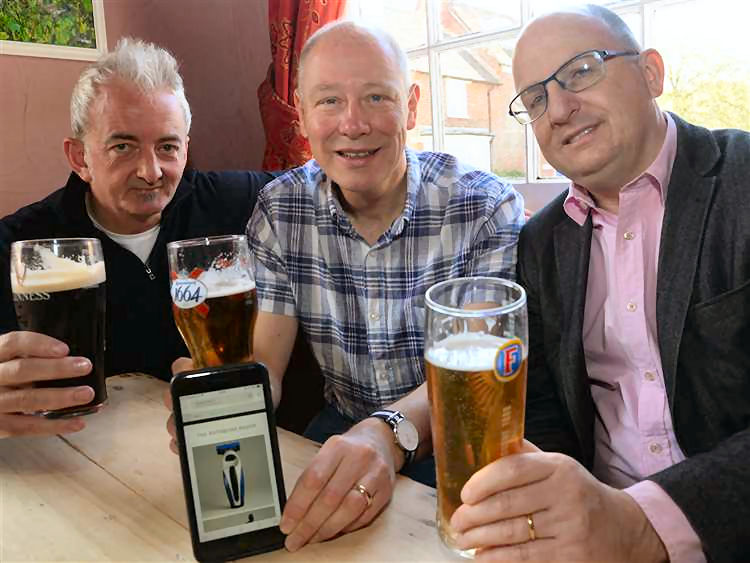
Mark Crosbie-Smith, Stuart Abel and David Bruce - three of the friends
behind the development of the new razor.
Impressed with the shave, he pitched the idea of developing a new type
of razor to his long-time friends, designer Mark Crosbie-Smith,
scientist Stuart Abel, and technology expert Andy Thornton.
“It was discovered by complete mistake,” Mr Bruce, 46, said.
“I shaved by just holding the blade cartridge close to my face.
"I thought 'wow, that gives me a really close shave'.
“We have no background in razors whatsoever – we’re from different
industries – and are just a bunch of mates.”
The quartet worked on the idea at the Duke of Cumberland in The Street,
Barham, twice a week over the next four years.
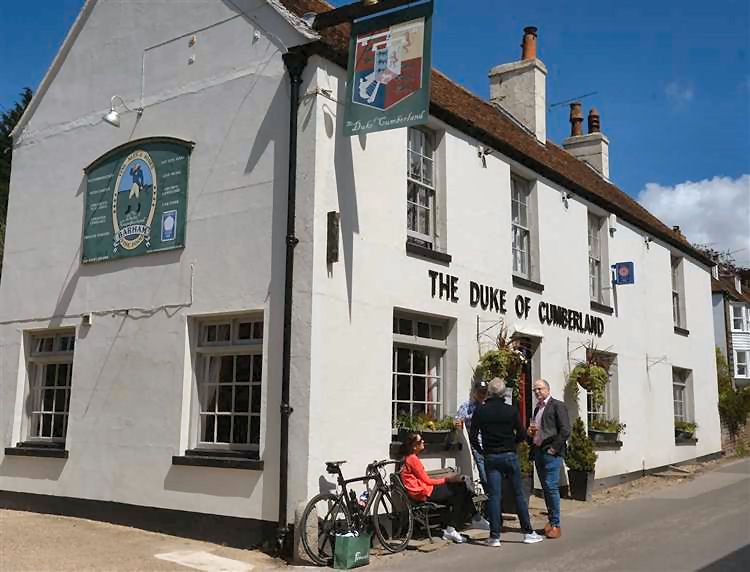
The entrepreneurs worked on the idea over drinks at the Duke of
Cumberland pub.
While there, they designed the product, secured the patents for it
across Europe and America and conducted their market research.
“We jokingly called the pub our office,” Mr Bruce continued.
“It’s been a hobby for us. We got to know Helen the landlady quite well.
“We ate a lot of crisps and actually drank more diet Coke and soft
drinks than beer while we worked there.
“Two of us are based in Barham, another in Bekesbourne and Andy is based
in San Francisco – he joined us through video link.”
The shaver, called Rathbone Razors, promises to combine "the closeness
of the cut-throat razor with the ease of use of a cartridge safety
razor".
“We’d like to take on the big guys,” Mr Bruce added.
“Our product is very different to what the likes of Gillette are
selling.
“Our data tells us the vast majority of men dislike shaving and of those
80% would recommend the Rathbone Razor.
"We think we’ve solved one of the world's problems.”
The handle will cost £19 and packs of four replacement blades £10.
Mr Bruce says they will be available to buy in November provided he
raises £20,000 for their production.
So far, he has generated more than £8,200 on the Rathbone Razors
Kickstarter page, which can be found at
https://www.kickstarter.com/projects/rathbonerazors
|
LICENSEE LIST
QUESTED Thomas Oct 1766-92
QUESTED Francis 1792
Sold to Henry and William Mackeson brewers of Hythe.
RAYNER James June 1792-1814
 KNOTT Richard 1814-21 dec'd
KNOTT Richard 1814-21 dec'd
KNOTT Rachel 1821-1829
PYNOR Thomas 1829-36+
SQUIRE Thomas 1839-42
 (age 40 in 1841
(age 40 in 1841 ) )
HORNSBY Charles F 1851-1871 dec'd (age 69 in 1871 ) )
  
HORNSBY Clara 1871+
STEVENS William 1871-76+ dec'd (age 52 in 1871 ) )

STEVENS Mrs Mary Ann 1879-94 dec (widow age 68 in 1891 ) )
 
STEVENS Charles 1894-97
PRYOR Robert 1897-1901

GAMESBY/GAUSBY James 1901-03 (age 35 in 1901 ) ) 
CROSBY George Henry 1902+

DUFFIELD Edward D 1903-Feb/07

HUCKSTEP G Feb/1907+ (Held a licence at Canterbury)

PAGE Thomas S 1904?-10
KEELER Harry 1910-12
HOPKINS Harry H 1912-May/14
 
BLEACH William May/1914-16
 (Of
Dover) (Of
Dover)
LOWE Thomas William 1916-Oct/37 dec'd
 
LOWE Mrs Alice Elsie Mary to Nov/1937
 (1938 name
given as KNOWLES) (1938 name
given as KNOWLES)
PEPPER Frank Nov/1937-45
 
STRINGER William Henry George dec1945-66
STRINGER Irene 1966-77
SWAIN Michael Brian 1977-80
WHITE Kenneth Joseph 1980-83
STEWART Christopher Ian 1983-99
O'SHEA John & Fiona 1999-2000
CASSIDY Shaun 2000-02
SPRULES Linda 2002-04
CORRIGAN Sally & Kevin 2004-07
GRAY Duncan & Karen 2007
GASKELL Eric and BROWN Helen 12 July 2007+
https://pubwiki.co.uk/DukeofCumberland.shtml
https://www.whatpub.com/duke-of-cumberland
1933 Changed from Mackeson to Jude, Hanbury and Co. of Canterbury.
 From Bagshaw Directory 1847 From Bagshaw Directory 1847
 From Melville's Directory 1858 From Melville's Directory 1858
 From the Post Office Directory 1862 From the Post Office Directory 1862
 From the Post Office Directory 1874 From the Post Office Directory 1874
 From the Post Office Directory 1882 From the Post Office Directory 1882
 From the Post Office Directory 1891 From the Post Office Directory 1891
 From the Kelly's Directory 1899 From the Kelly's Directory 1899
 From the Kelly's Directory 1903 From the Kelly's Directory 1903
 From the Post Office Directory 1913 From the Post Office Directory 1913
 From the Kelly's Directory 1934 From the Kelly's Directory 1934
 From the Post Office Directory 1938 From the Post Office Directory 1938
 From the Dover Express From the Dover Express
 Whitstable Times
and Herne Bay Herald Whitstable Times
and Herne Bay Herald
|
















